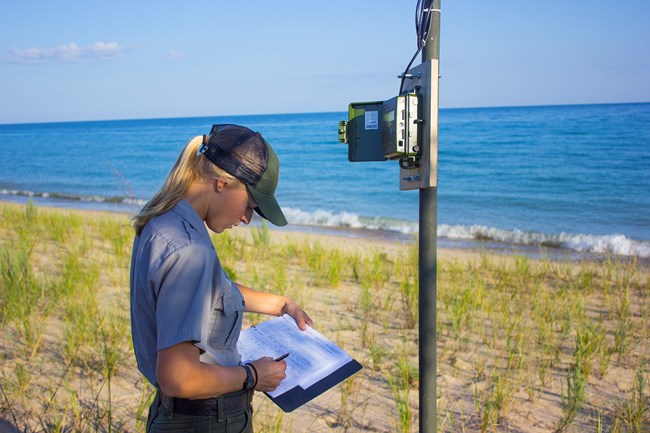
photo by Colleen Otte.
Monitoring Bats in National Parks within the NPS Great Lakes Inventory and Monitoring Network
Some people may only think about bats in October, remembering the scary bats of Halloween lore, but researchers, resource managers and the like are thinking about bats all year long.
Turns out, bats fulfill essential roles in ecosystems. What’s actually scary is not the bat, but the fact that several species are on a steep decline.
The Indiana bat is federally endangered; the northern long-eared bat, federally threatened. According to Katy Goodwin, co-investigator for the National Park Service Great Lakes Inventory & Monitoring Network’s bat monitoring program, “There’s been discussion about listing the little brown bat, but it hasn’t actually been listed yet. That population has decreased dramatically, on the order of 95 percent mortality. It’s scary.”
Efforts are underway via the collaboration of the Inventory & Monitoring Network and nine national parks in the upper Midwest to monitor bat activity and assess changes in patterns and trends in bat populations in those parks. Knowledge gained will help minimize threats to bats through resource protection and education; documenting which species reside where will help better inform management decisions that have potential impacts on those populations.
“The impetus for starting this project was concern over the impacts that white-nose syndrome (WNS) has had on bat populations especially in the eastern U.S.,” Goodwin said. “As that disease has moved west, it’s now affecting bats in the Great Lakes.”
The researchers’ goal is to establish a long-term monitoring program using remotely located recorders that can record the ultrasonic bat calls. By collecting these recordings from the same sites each year, scientists can document which species are present in each park. Then they can determine if there are fewer recorded calls from any species, which could indicate a population decline.
Nine species have been identified as possibly present in the parks by their recorded calls. The little brown bat, northern long-eared bat, and Indiana bat are closely related, and are all severely affected by WNS. The tri-colored bat (formerly called the eastern pipistrelle), a less common and less widely distributed species, is also affected. The evening bat’s territory just barely enters the southern portion of the region, so it may be present in the southernmost Great Lakes national parks. Also present are the big brown bat, red bat, hoary bat, and silver-haired bat, but these species are typically less affected by WNS. “That’s not to say they aren’t affected at all,” Goodwin clarifies, “but because they don’t hibernate in caves where the disease-causing fungus can run rampant, they are less exposed to the disease”.
“We’ve found species distribution in most parks to be what we expected, but it’s good to actually prove it,” she said. “This year will be interesting - looking at 2017 data - because WNS was first reported in Michigan, Minnesota, and Wisconsin around 2014 -2015, and I’ve heard it’s usually the third year after it starts that you see a big crash. That would be coming up, so it’ll be really interesting to see what happens with this year’s data.” For more information about WNS click here.
For anyone who doesn’t like to get eaten alive by bugs the results of this monitoring should give pause: bats feed almost exclusively on insect pests. In fact, one study estimates that bats save the U.S. agricultural industry $22.9 billion each year by reducing pesticide application costs. Acting as one of nature’s pest controllers is just one of many ways bats benefit humans and entire ecosystems. For additional information on bats, visit https://www.nps.gov/subjects/bats/index.htm.
Last updated: October 18, 2018
